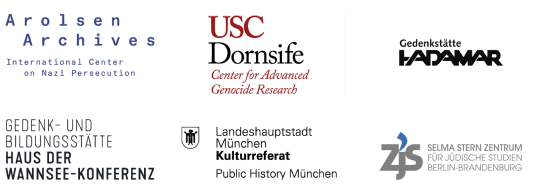Annotations
Bielefeld
December 1941
In front of the “Kyffhäusersaal” (the hall at the inn) several deportees wait for the omnibus to take them to the main train station. A public transport official can be seen standing in the background.
Annotations
Keywords
2
Historical context
Deportation von Bielefeld nach Riga am 13.12.1941
As early as December 11, 1941, more than 400 people from the Bielefeld Gestapo district persecuted as Jews were crammed into the "Kyffhäuser" inn in the center of Bielefeld, which was used as an assembly camp. After being robbed of their valuables, they had to spend two nights on a bed of straw. Then, on December 13, the deportees were taken to the main train station on city buses guarded by municipal police officers. Their luggage was transported by the “Roter Radler” forwarding company. Jewish forced laborers from the nearby “Umerziehungslager Schloßhofstraße” (a labor re-education camp on Schloßhofstraße) had to help load the luggage.
A certain number of Jews from Münster and the surrounding area were already seated on the train that deported the East Westphalians to the Riga ghetto on a three-day journey in sealed third-class railcars. After another stop in Osnabrück, the final number of deportees on the train was 1,031. According to the report by survivor Arthur Sachs, the deportees on the train sang "Nun ade, du mein lieb Heimatland” (Farewell my dear homeland – a well-known folk song). Only 48 of the 420 people deported from the district of Bielefeld survived the Shoah.
Sources
About the image series
The series of 25 pictures in the format 6 x 6 cm depicts the chronology of the deportation of about 420 people from the district of Bielefeld. The photos were taken at three different locations: inside the "Kyffhäuser” inn, which served as an assembly camp; in front of the entrance during the pick-up and loading of luggage; and at the customs shed and on the platform of Bielefeld's main train station. The pictures of the train show deportees from the city of Münster and the surrounding area leaning out of the windows. The square prints are included in the 1941 Bielefeld War Chronicle, as are 15 enlargements of those images that were most telling in the eyes of the photographer. The comments written on the back of the pictures by the photographer were transcribed onto the pages of the chronicle with only one change: the inscription "to Riga" on the back of the first picture was replaced by the words "towards the east."
Photographer
Georg Hübner, police assistant
Georg Hübner, born in Bielefeld in 1895, attended school until the 9th grade and worked as a graphic designer before he was drafted in 1916. He was promoted to the rank of II Sergeant, was awarded numerous medals, and continued to fight in a Freikorps (volunteer corps) in Upper Silesia after the war had ended. After three years in an “Arbeitsgemeinschaft” (living and working community) for former members of the "Brigade Ehrhardt" in Bavaria and a brief period of membership in the NSDAP, he returned to Bielefeld in 1923. A degenerative eye condition made it impossible for him to resume his work. After rejoining the party in December 1932, his status as an "old fighter" enabled him to get better and better jobs in the civil service. In the end, he was promoted to police assistant. After his dismissal in 1945, Hübner was reintegrated in 1953 and held low-level civil service positions until his retirement. He died in 1968.
Provenance
The director of Stadtmuseum Bielefeld, Dr. Eduard Schoneweg, was responsible for compiling the city’s chronicle. He commissioned Georg Hübner to make a photographic record of the first deportation of Jews from Bielefeld. Schoneweg refused to hand over the war chronicle to the city of Bielefeld until 1948. In the course of investigations leading to the Bielefeld "Gestapo Trial" in 1961, the picture series was used and reproduced twice. These copies are now kept in the Bundesarchiv (Federal Archives) and the Landesarchiv (State Archives) of North Rhine-Westphalia. The original is preserved in Stadtarchiv Bielefeld.
Call number at source archive
Stadtarchiv Bielefeld, Bestand 300,11/Kriegschronik der Stadt Bielefeld, Bd. 4: Kriegschronik 1941, 408
Title at source archive
Acknowledgements
We would like to thank Dr. Jochen Rath from Stadtarchiv Bielefeld as well as Erika Rosenfeld and Dr. Annette Hennings from the Detmold branch of the Landesarchiv for their kind support with the research.
Text and research by Lisa Paduch.
Kooperationsverbund #LastSeen. Bilder der NS-Deportationen Dr. Alina Bothe Projektleiterin
c/o Selma Stern Zentrum für Jüdische Studien Berlin-Brandenburg
Freie Universität Berlin
Habelschwerdter Allee 34A
14195 Berlin
lastseen@zedat.fu-berlin.de
Ein Kooperationsprojekt von

Gefördert durch

Datenschutz | Impressum